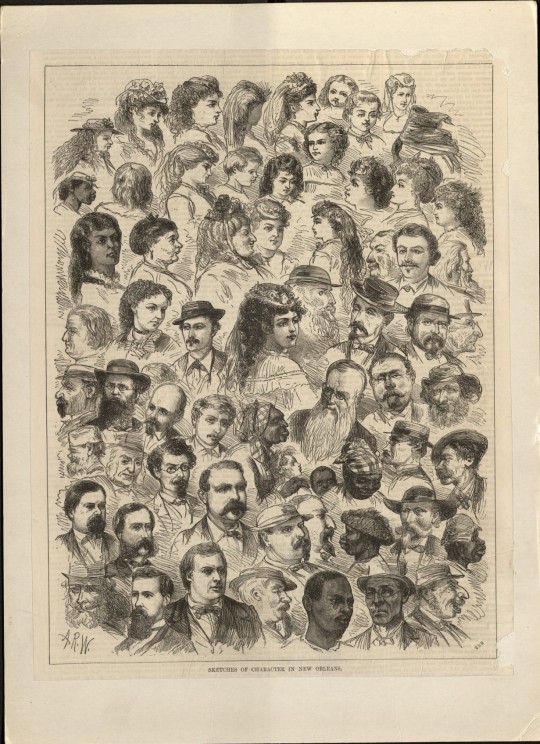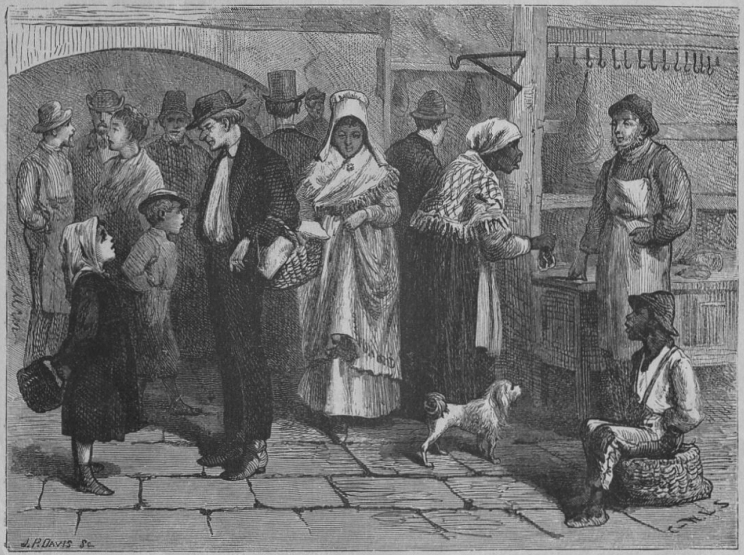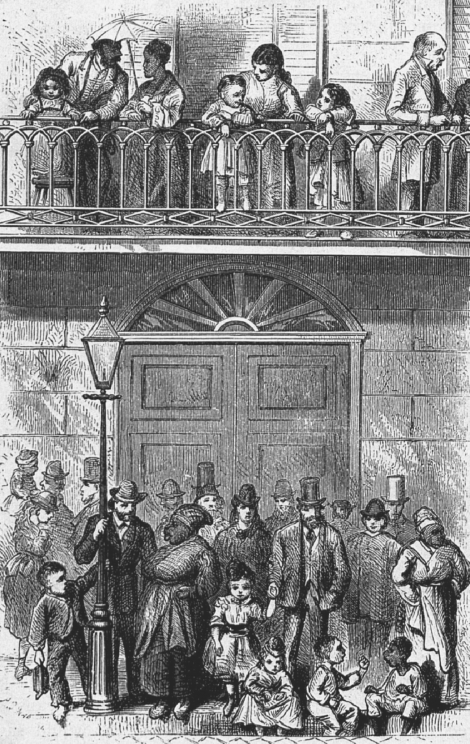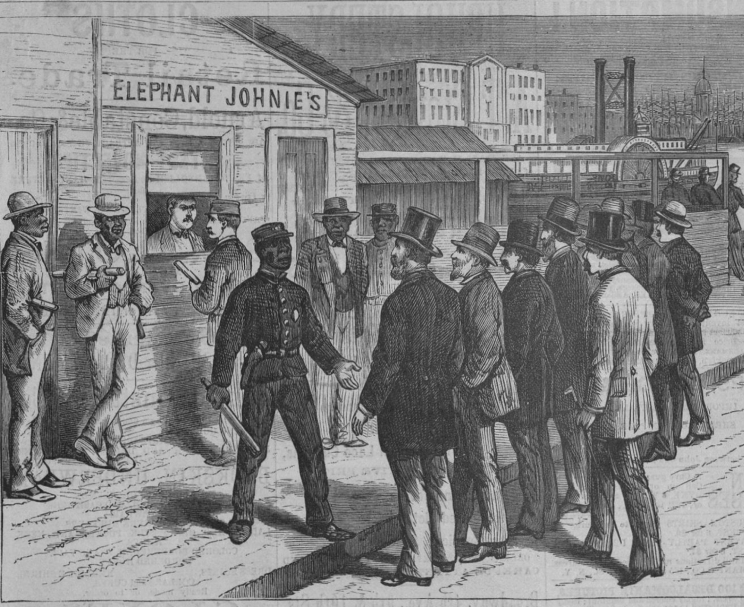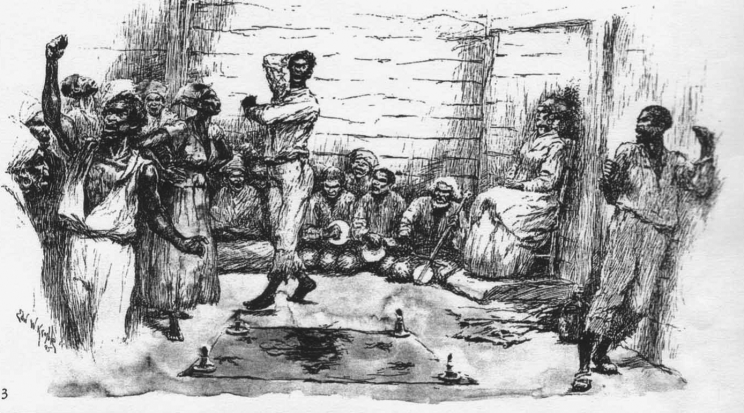The three-minute version, anyway, courtesy of Teaching Books. I could go on for a lot longer about why I wrote a book for kids about Reconstruction. Go ahead — try me!
Viewing: Blog Posts Tagged with: Reconstruction, Most Recent at Top [Help]
Results 1 - 25 of 26
Blog: Bartography (Login to Add to MyJacketFlap)
JacketFlap tags: Chris Barton, Teaching Books, Reconstruction, The Amazing Age of John Roy Lynch, Add a tag
Blog: Bartography (Login to Add to MyJacketFlap)
JacketFlap tags: The Amazing Age of John Roy Lynch, Christensen brothers, Nick Patton, Picturebooking, The Nutcracker Comes to America, Uncategorized, podcasts, Texas Bluebonnet Award, Chris Barton, Jennifer Ziegler, Reconstruction, Add a tag
Nick Patton hosted me this week for an interview on the newest edition of his Picturebooking podcast. I loved talking with Nick about ‘The Nutcracker’ Comes to America and The Amazing Age of John Roy Lynch and about being married to my favorite author in the whole world, as well as answering his curveballier questions. […]
Blog: Bartography (Login to Add to MyJacketFlap)
JacketFlap tags: Don Tate, Chris Barton, Reconstruction, Eerdmans, voting rights, The Amazing Age of John Roy Lynch, Reading While White, K.T. Horning, Add a tag
As a friend pointed out to me, K.T. Horning literally wrote the book on reviewing children’s literature. So her review of The Amazing Age of John Roy Lynch for the Reading While White blog would have meant a lot to me no matter what. But I especially appreciate Horning’s recognition of the honesty and authenticity […]
Blog: Bartography (Login to Add to MyJacketFlap)
JacketFlap tags: Socialit, Don Tate, Chris Barton, BookPeople, Kelly Starling Lyons, Reconstruction, The Amazing Age of John Roy Lynch, Poet: The Remarkable Story of George Moses Horton of Ch, Hope's Gift, Add a tag
Blog: Bartography (Login to Add to MyJacketFlap)
JacketFlap tags: Elizabeth Bird, Reconstruction, Eerdmans, The Amazing Age of John Roy Lynch, School Library Journal, Don Tate, Chris Barton, Add a tag
Elizabeth Bird, librarian extraordinaire, had a lot to say this week about The Amazing Age of John Roy Lynch on her School Library Journal blog. This book has received some great attention, but there’s nothing quite as rewarding for an author as knowing without a doubt that someone has made a point of thinking deeply […]
Blog: Bartography (Login to Add to MyJacketFlap)
JacketFlap tags: Don Tate, Chris Barton, Reconstruction, Eerdmans, The Amazing Age of John Roy Lynch, Add a tag
Here are the most timely and intriguing items about Reconstruction that I found this past week. (What did I miss? Let me know in the comments…) From The Chronicle of Higher Education: For scholars of African-American studies, the police killings of unarmed black men in several cities over the past year have been personally searing […]
Blog: Bartography (Login to Add to MyJacketFlap)
JacketFlap tags: Don Tate, Chris Barton, Reconstruction, Eerdmans, The Amazing Age of John Roy Lynch, Mississippi Book Festival, Add a tag
Here are the three most notable items pertaining to Reconstruction that I found this past week. Or, at least, two notable items preceded by one blatantly self-promotional one. (What did I miss? Let me know in the comments…) In advance of this month’s inaugural Mississippi Book Festival, this interview with me from Jackson’s Clarion-Ledger: Question: […]
Blog: Bartography (Login to Add to MyJacketFlap)
JacketFlap tags: Reconstruction, Eerdmans, The Amazing Age of John Roy Lynch, Don Tate, Chris Barton, Add a tag
Here are the most timely and intriguing items about Reconstruction that I found this past week. (What did I miss? Let me know in the comments…) From the University of South Carolina Beaufort: The University of South Carolina Beaufort (USCB), in partnership with the City of Beaufort, Penn Center, and the University Of South Carolina […]
Blog: Bartography (Login to Add to MyJacketFlap)
JacketFlap tags: The Amazing Age of John Roy Lynch, Mississippi Book Festival, Chris Barton, book festivals, Reconstruction, Add a tag
…is taking shape. And I’m pleased to say that I’m among the authors who will be participating in Jackson on August 22.
Where better for me to share The Amazing of Age of John Roy Lynch with the public than in the city where he began his political rise?
“In 1868 the U.S. government appointed a young Yankee general as governor of Mississippi. The whites who had been in charge were swept out of office. By river and by railroad, John Roy traveled to Jackson to hand Governor Ames a list of names to fill those positions in Natchez. After John Roy spoke grandly of each man’s merits, the governor added another name to the list: John Roy Lynch, Justice of the Peace.”
Blog: Bartography (Login to Add to MyJacketFlap)
JacketFlap tags: Don Tate, Chris Barton, Reconstruction, Eerdmans, The Amazing Age of John Roy Lynch, Add a tag
I’m excited to the see the word get out — and the favorable reviews come in — for my book with Don Tate, The Amazing Age of John Roy Lynch (Eerdmans Books for Young Readers). Here’s a sampling of the latest batch:
From Kendal Rautzhan’s nationally syndicated column:
“This inspirational story of John Roy Lynch, going from a teenage slave to a U.S. Congressman in just 10 years, should not be missed.”
From librarian Tasha Saecker’s Waking Brain Cells blog:
“An important book focused on an important figure in a dynamic time in American history, this picture book biography will inform new audiences about the potential for both progress and defeat during [Reconstruction].”
From the Mississippi Library Commission’s MLC Reference Blog:
“Growing up in Mississippi, we remember learning about John Roy Lynch in history class. We wish this book had been around then, because it is truly amazing.”
From WCMU’s Children’s Bookshelf:
“[A] powerful story … Chris Barton’s descriptions of the time period in which John Roy Lynch lived and the challenges and heartache that he experienced may have a profound impact on young people.”
Blog: Bartography (Login to Add to MyJacketFlap)
JacketFlap tags: podcasts, book recommendations, Don Tate, Chris Barton, Reconstruction, Eerdmans, Colby Sharp, The Amazing Age of John Roy Lynch, Booklandia, Jon Samuelson, Parents Choice Awards, Add a tag

This past week has brought a couple of happy developments for my new book with Don Tate, The Amazing Age of John Roy Lynch (Eerdmans Books for Young Readers).
First, the book has received a Silver Honor from the Parents’ Choice Awards. Thank you, Parents’ Choice!
And another big thank you goes to Colby Sharp and Jon Samuelson for including The Amazing Age of John Roy Lynch (along with Bob Shea’s Ballet Cat and Victoria Jamieson’s Roller Girl) in the latest episode of the Booklandia podcast.
I love the surprise in Jon’s voice when he realizes that the story of Lynch’s 10-year rise from slavery to the U.S. House of Representatives during Reconstruction is nonfiction rather than historical fiction. I also appreciate the thorough notes on this episode — very helpful, guys.
Blog: Bartography (Login to Add to MyJacketFlap)
JacketFlap tags: Don Tate, Chris Barton, Reconstruction, Eerdmans, The Amazing Age of John Roy Lynch, Smithsonian Asian Pacific American Center, Add a tag
“[F]our reasons why most of us need to read this book” sounds pretty terrific to me. Thanks, APAC!
Blog: Bartography (Login to Add to MyJacketFlap)
JacketFlap tags: Don Tate, Chris Barton, Reconstruction, The Amazing Age of John Roy Lynch, Add a tag
…you have got to take a look at the outstanding site Mapping Occupation: Force, Freedom and the Army in Reconstruction, especially if you’re an educator, history buff, or lover of great design.
For me, it’s fascinating to see how the presence of the U.S. Army grew and dwindled in the South — especially in John Roy Lynch’s Mississippi — during the era that Don Tate and I cover in The Amazing Age of John Roy Lynch. And it’s a reminder of how much more there will always be for us to learn about our past.
Gregory P. Downs and Scott Nesbit headed up the project, but the whole team deserves heaps of praise for this illuminating and highly interactive look at Reconstruction.
Blog: Bartography (Login to Add to MyJacketFlap)
JacketFlap tags: Conference, Don Tate, Chris Barton, Reconstruction, Eerdmans, The Amazing Age of John Roy Lynch, Fay B. Kaigler Children's Book Festival, Add a tag

I’m excited to be returning this week to the fantastic Fay B. Kaigler Children’s Book Festival this week at the University of Southern Mississippi in Hattiesburg.
Much of the festival requires registration, but the Hattiesburg American reports that there are exceptions, and my session is one of them:
First panel open to the public: Chris Barton, Don Tate and Kathleen Merz discuss “The Amazing Age of John Roy Lynch,” a picture book biography of the Mississippi slave-turned-congressman, 11:30 a.m. April 8, Thad Cochran Center ballrooms.
(Kathleen is the editor of The Amazing Age of John Roy Lynch, and I’m delighted that she’ll be joining Don and me. On only one other occasion in my career have I gotten together in person at the same time with both the editor and the illustrator of one of my books, so this will be special.)
Another open-to-the-public panel ends the festival on Friday, with David Levithan and Deborah Wiles discussing their relationship as editor an author.
Whether you’re able to make it to the beginning of the festival, the end, or the whole thing, you’re in for a treat. If you see me, won’t you please say hello?
Blog: Bartography (Login to Add to MyJacketFlap)
JacketFlap tags: Eerdmans, The Amazing Age of John Roy Lynch, Don Tate, Reconstruction, Add a tag
(Narrated by yours truly.)
Many thanks to Don Tate and Eerdmans Books for Young Readers for their work in putting this together, and to John Roy Lynch himself for the inspiring quote at the end.
You’ll find lots more about the book here.
Blog: Bartography (Login to Add to MyJacketFlap)
JacketFlap tags: The Amazing Age of John Roy Lynch, Don Tate, Chris Barton, Reconstruction, Eerdmans, Eric Foner, Add a tag
“Citizenship, rights, democracy — as long as these remain contested, so will the necessity of an accurate understanding of Reconstruction.”
That quote comes from “Why Reconstruction Matters,” a new, short essay by Eric Foner, author of Reconstruction: America’s Unfinished Revolution 1863-1877 and the Pulitzer-prize-winning DeWitt Clinton Professor of History at Columbia University. I can’t recommend enough taking a few minutes to read it.
While Don Tate was working on the illustrations for The Amazing Age of John Roy Lynch, our publisher asked Professor Foner to have a look at the text. Here’s what he had to say about our picture book biography of this young man who went from teenage slave to U.S. congressman in ten years:
Like adults, young readers should know about the era of Reconstruction and the remarkable individuals who struggled to give real meaning to the freedoms blacks achieved during the Civil War. John Roy Lynch was one of them and he is brought vividly to life in this book.
I’m thankful to Foner not only for those kind words about our book, but especially for all the work he’s done to shape our modern understanding of the Reconstruction era.
“Preoccupied with the challenges of our own time,” he writes in this New York Times essay, “Americans will probably devote little attention to the sesquicentennial of Reconstruction, the turbulent era that followed the conflict.”
Not if I can help it.
Blog: Bartography (Login to Add to MyJacketFlap)
JacketFlap tags: Fay B. Kaigler Children's Book Festival, Don Tate, Chris Barton, giveaway, BookPeople, Texas Library Association, Reconstruction, Eerdmans, San Antonio Book Festival, The Amazing Age of John Roy Lynch, Bartography Express, Add a tag
This month, at least one subscriber to my Bartography Express newsletter — maybe more! — will win a copy of my new brand-new book.
To celebrate next week’s publication of The Amazing Age of John Roy Lynch (illustrated by Don Tate, and published by Eerdmans Books for Young Readers), the children’s department staffers at Austin’s BookPeople came up with several questions for me to answer. I hope you enjoy my answers as much as I appreciate their questions.
If you’re not already receiving Bartography Express, click the image below for a look. If you like what you see, click “Join” in the bottom right corner, and you’ll be in the running for the giveaway next week. Good luck!
Blog: Shelf-employed (Login to Add to MyJacketFlap)
JacketFlap tags: nonfiction, bio, Reconstruction, Advance Reader Copy, African Americans, John Roy Lynch, Add a tag
.jpg) Barton, Chris. 2015. The Amazing Age of John Roy Lynch. Grand Rapids, MI: Eerdmans. Illustrated by Don Tate.
Barton, Chris. 2015. The Amazing Age of John Roy Lynch. Grand Rapids, MI: Eerdmans. Illustrated by Don Tate.
The Amazing Age of John Roy Lynch is a nonfiction picture book for school-age readers and listeners. More than just an inspirational story of a former slave who becomes a landholder, judge, and United States Congressman, it is a story that focuses on the great possibilities presented during the period of Reconstruction.
"In 1868 the U.S. government appointed a young Yankee general as a governor of Mississippi. The whites who had been in charge were swept out of office. By river and by railroad, John Roy traveled to Jackson to hand Governor Ames a list of names to fill those positions in Natchez. After John Roy spoke grandly of each man's merits, the governor added another name to the list: John Roy Lynch, Justice of the Peace.
Justice. Peace. Black people saw reason to believe that these were now available to them. Just twenty-one, John Roy doubted that he could meet all those expectations. But he dove in and learned the law as fast as he could."
Sadly, the reason that John Roy Lynch's story is amazing to today's reader is because the opportunities that abounded during Reconstruction dried up and disappeared as quickly as they had come. The period of hope and optimism for African Americans in the years from 1865 to 1877, gets scant attention today. The life of John Roy Lynch is an excellent lens through which to view Reconstruction.
To make sometimes difficult scenes accessible to younger readers, Don Tate employs a self-described, "naive ... even whimsical" style. It works well with the sepia-tinged hues that help to set the time frame.
The Amazing Age of John Roy Lynch is a powerful, historical reminder of what was, what might have been, and what is.
A Timeline, Historical Note, Author's Note, Illustrator's Note, For Further Reading, and maps round out the book.
Advance Reader Copy provided by
Blog: Bartography (Login to Add to MyJacketFlap)
JacketFlap tags: Don Tate, Chris Barton, Reconstruction, The Amazing Age of John Roy Lynch, Facing History and Ourselves, Add a tag
It’s still a month away from the publication date of my book with Don Tate, The Amazing Age of John Roy Lynch, the true story of a young man who rose from slavery to the U.S. Congress during the Civil War and Reconstruction.
About that latter, terribly overlooked period, I could not ask for a better summation of why it’s such an important era in U.S. history than this three-minute video published today by Facing History and Ourselves. I hope you’ll watch it and be inspired to learn more.
Blog: Bartography (Login to Add to MyJacketFlap)
JacketFlap tags: Reconstruction, Eerdmans, The Amazing Age of John Roy Lynch, Don Tate, Chris Barton, Add a tag
You know, when you spend the better part of a decade working on a 50-page picture book, I suppose it’s OK to get a little excited when Publishers Weekly both gets and appreciates what you were going for all those years:
The whole thing is available here, but this is my favorite part:
Barton offers an immersive, engaging, and unflinching portrait of the difficulties of the Reconstruction era, while Tate’s cartoonlike artwork softens moments of cruelty and prejudice without diminishing them.
Blog: Bartography (Login to Add to MyJacketFlap)
JacketFlap tags: The Birth of a Nation, Don Tate, Chris Barton, Reconstruction, The Amazing Age of John Roy Lynch, Add a tag

Rather than share the Klan-glorifying poster for The Birth of a Nation, I thought I’d offer this depiction from The Amazing Age of John Roy Lynch.
There’s been lots published this weekend about the 100th anniversary of D. W. Griffith’s film The Birth of a Nation — about how its technical greatness and unprecedented box-office success were at least matched and arguably surpassed by the vileness of its racist depictions of African Americans.
By one way of reckoning, this week — February 8, to be exact — can be called the 100th birthday of the medium that many of us have spent our lives enthralled with: the feature film. But don’t expect any parades, fireworks, grand speeches, or other shows of celebration. That’s because the film that premiered at Clune’s Auditorium in Los Angeles on February 8, 1915, was D. W. Griffith’s The Clansman, soon to be retitled The Birth of a Nation — the most virulently racist major movie ever released in the U.S.
Birth Of A Nation is the movie where many of the values associated with American filmmaking—complex intercutting, massed crowds of extras contrasted with close-ups of actors, carefully edited suspense and chase scenes—get their first really clear, fully formed expression. It’s also unquestionably white supremacist and racist. It represents a key point in the history of American art, and is animated by some of the ugliest rhetoric America ever produced.
The film is credited with reviving the racist KKK, who adopted it as a recruitment tool. “The Ku Klux Klan had been kind of a dead organisation by 1915, but when the film [came out and became a hit] the KKK was refounded, capitalised on [the film’s success] and in the 1920s became a massive organisation at the peak of nativist fervour in the United States,” says Paul McEwan.
“The Birth of a Nation” was the last straw for [William Monroe] Trotter. A proud intellectual (Harvard’s first black Phi Beta Kappa student) and a proud “race man,” Trotter was appalled, like many African-Americans, by Griffith’s film. And he was appalled that President Woodrow Wilson, whom he had rallied black voters to support, had screened “The Birth of a Nation” in the White House — the first film to be shown there.
What makes “Birth’’ most offensive is its depiction of its black characters — all of the prominent ones performed by white actors in blackface — during Reconstruction. Griffith depicts defeated Southerners being terrorized (and even disenfranchised from voting) by illiterate, corrupt and uncouth former slaves (seeking interracial marriage) under the influence of white Northern carpetbaggers. (A view still held by many 1915 historians, but long ago discredited).
“Long ago discredited,” yes, but still at least indirectly influential. Modern historians have given Reconstruction a bit of the attention that it deserves, but there’s been exactly one hugely commercially successful depiction of that period in the American story, and it’s Griffith’s movie.
Whether audiences at the time of The Birth of a Nation‘s release accepted Griffith’s vision, or whether they were repulsed by it and just wanted to forget the whole thing, it’s not hard to see how those attitudes could get passed along — through families, and through our schools, and through our culture in general. And with no competing mainstream force to counter the impressions left by such a film, what’s to stop them from lingering among us?
 Which brings me to The Amazing Age of John Roy Lynch. More specifically, it brings me to a period in Lynch’s long life not covered by the main text in my upcoming book with Don Tate.
Which brings me to The Amazing Age of John Roy Lynch. More specifically, it brings me to a period in Lynch’s long life not covered by the main text in my upcoming book with Don Tate.
Our book focuses on his early years — his rise from slavery to the U.S. House of Representatives in just ten years. But after his stints in Congress, and after his service as a major in the Army during the Spanish-American War, Lynch became a historian. He had a central goal in mind: “placing before the public accurate and trustworthy information relative to Reconstruction” in the wake of much misinformation about that period.
From the timeline in The Amazing Age of John Roy Lynch:
1913 — Writes The Facts of Reconstruction to correct racist distortions put forth by white historians.
1915 — The Birth of a Nation, a Hollywood film misrepresenting Reconstruction and glorifying the Klan, becomes wildly popular and warps Americans’ views of history for generations to come.
His timing, you can see, wasn’t great. And, more crucially, and his medium was no match for Griffith’s.
But John Roy Lynch had — and has — history on his side. And I remain optimistic that his vision can ultimately win out.
Blog: Bartography (Login to Add to MyJacketFlap)
JacketFlap tags: Don Tate, Chris Barton, Reconstruction, Eerdmans, The Amazing Age of John Roy Lynch, Add a tag
I don’t remember how I spent Christmas of 2006, but according to the files on my computer I spent at least part of the day doing my very first bit of documented work on what would become The Amazing Age of John Roy Lynch.
Eight years later, look what arrived as a late Christmas/early New Year’s gift! It’s my very first finished copy of that book, and it’s gorgeous. Illustrator Don Tate and the folks at Eerdmans Books for Young Readers have done a marvelous job, and I’ve so enjoyed getting to show the book off to friends and family over the holidays.
The publication date is April 2, so there’s not much longer to wait for this book. And, really, having already waited more than eight years for it, three more months isn’t long at all.
Blog: OUPblog (Login to Add to MyJacketFlap)
JacketFlap tags: Books, Language, old, German, english, Dutch, Linguistics, Scandinavian, Latin, necromancy, reconstruction, *Featured, linguistic, george walkden, linguistic necromancy: a guide for the uninitiated, proto, Add a tag
It’s fairly common knowledge that languages, like people, have families. English, for instance, is a member of the Germanic family, with sister languages including Dutch, German, and the Scandinavian languages. Germanic, in turn, is a branch of a larger family, Indo-European, whose other members include the Romance languages (French, Italian, Spanish, and more), Russian, Greek, and Persian.
Being part of a family of course means that you share a common ancestor. For the Romance languages, that mother language is Latin; with the spread and then fall of the Roman empire, Latin split into a number of distinct daughter languages. But what did the Germanic mother language look like? Here there’s a problem, because, although we know that language must have existed, we don’t have any direct record of it.
The earliest Old English written texts date from the 7th century AD, and the earliest Germanic text of any length is a 4th-century translation of the Bible into Gothic, a now-extinct Germanic language. Though impressively old, this text still dates from long after the breakup of the Germanic mother language into its daughters.
How does one go about recovering the features of a language that is dead and gone, and which has left no records of itself in spoken or written form? This is the subject matter of linguistic necromancy – or linguistic reconstruction, as it is more conventionally known.
The enterprise, dubbed “darkest of the dark arts” and “the only means to conjure up the ghosts of vanished centuries” in the epigraph to a chapter of Campbell’s historical linguistics textbook, really got off the ground in the 1900s due to a development of a toolkit of techniques known as the comparative method.
Crucial to the comparative method was a revolutionary empirical finding: the regularity of sound change. Though it has wide-reaching implications, the basic finding is simple to grasp. In a nutshell: it’s sounds that change, not words, and when they change, all words which include those sounds are affected.

Let’s take an example. Lots of English words beginning with a p sound have a German counterpart that begins with pf. Here are some of them:
- English path: German Pfad
- English pepper: German Pfeffer
- English pipe: German Pfeife
- English pan: German Pfanne
- English post: German Pfoste
If the forms of words simply changed at random, these systematic correspondences would be a miraculous coincidence. However, in the light of the regularity of sound change they make perfect sense. Specifically, at some point in the early history of German, the language sounded a lot more like (Old) English. But then the sound p underwent a change to pf at the beginning of words, and all words starting with p were affected.
There’s much more to be said about the regularity of sound change, since it underlies pretty much everything we know about language family groupings. (If you’re interested in finding out more, Guy Deutscher’s book The Unfolding of Language provides an accessible summary.) But for now let’s concentrate on its implications for necromantic purposes, which are immense.
If we want to invoke the words and sounds of a long-dead language like the mother language Proto-Germanic (the ‘proto-’ indicates that the language is reconstructed, rather than directly evidenced in texts), we just need to figure out what changes have happened to the sounds of the daughter languages, and to peel them back one by one like the layers of an onion. Eventually we’ll reach a point where all the daughter languages sound the same; and voilà, we’ve conjured up a proto-language.
There’s more to living languages than just sounds and words though. Living languages have syntax: a structure, a skeleton. By contrast, reconstructed protolanguages tend to look more like ghosts: hauntingly amorphous clouds of words and sounds. There are practical reasons why the reconstruction of proto-syntax has lagged behind. One is simply that our understanding of syntax, in general, has come a long way since the work of the reconstruction pioneers in the 19th century.
Another is that there is nothing quite like the regularity of syntactic change in syntax: how can we tell which syntactic structures correspond to each other across languages? These problems have led some to be sceptical about the possibility of syntactic reconstruction, or at any rate about its fruitfulness. Nevertheless, progress is being made. To take one example, English is a language that doesn’t like to leave out the subject of a sentence. We say “He speaks Swahili” or “It is raining”, not “Speaks Swahili” or “Is raining”. Though most of the modern Germanic languages behave the same, many other languages, like Italian and Japanese, have no such requirement; speakers can include or omit the subject of the sentence as the fancy takes them. Was Proto-Germanic like English, or like Italian or Japanese, in this respect? Doing a bit of necromancy based on the earliest Germanic written records suggests that Proto-Germanic was, like the latter, quite happy to omit the subject, at least under certain circumstances.Of course the issue is more complex than that – Italian and Japanese themselves differ with regard to the circumstances under which subjects can be omitted.
Slowly but surely, though, historical linguists are starting to add skeletons to the reanimated spectres of proto-languages.
The post Linguistic necromancy: a guide for the uninitiated appeared first on OUPblog.
Blog: OUPblog (Login to Add to MyJacketFlap)
JacketFlap tags: New Orleans, civil war, America, reconstruction, *Featured, Images & Slideshows, American Civil War History, Great New Orleans Kidnapping Case, Michael A. Ross, Mollie Digby, race law justice reconstruction era, racial politics, reconstruction era, Books, History, Add a tag
The Reconstruction era was a critical moment in the history of American race relations. Though Abraham Lincoln’s Emancipation Proclamation made great strides towards equality, the aftermath was a not-quited newly integrated society, greatly conflicted and rife with racial tension. At the height of Radical Reconstruction, in June 1870, seventeen-month-old Irish-American Mollie Digby was kidnapped from her home in New Orleans — allegedly by two Afro-Creole women. In The Great New Orleans Kidnapping Case: Race, Law, and Justice in the Reconstruction Era, Michael A. Ross offers the first ever full account of this historic event and subsequent investigation that electrified the South. The following images set the scene of New Orleans during this time period of racial amalgamation, social friction, and tremendous unease.
Featured image: The City of New Orleans, Louisiana, Harper’s Weekly, May 1862. Public Domain via Wikimedia Commons.
The post Setting the scene of New Orleans during Reconstruction appeared first on OUPblog.
Blog: Bartography (Login to Add to MyJacketFlap)
JacketFlap tags: ballet, nonfiction, The Nutcracker, Don Tate, Chris Barton, Reconstruction, Eerdmans, Millbrook, Pioneers & Pirouettes, The Amazing Age of John Roy Lynch, Cathy Gendron, Christensen brothers, Harold Christensen, Lew Christensen, Willam Christensen, Add a tag
Inspired by Greg Leitich Smith’s annual list of books from our Austin writing community, I thought I’d start compiling the picture book biographies scheduled for publication in 2015 (including a pair of mine).
I know there are lots more picture book biographies on their way from publishers recognized by SCBWI, so if you’re interested in helping keep this list reasonably complete and up to date, please let me know in the comments which ones ought to be added. I’ll update and republish this post on a regular basis.
The Amazing Age of John Roy Lynch (Eerdmans), written by Chris Barton and illustrated by Don Tate
Drum Dream Girl: How One Girl’s Courage Changed Music (Houghton Mifflin Harcourt), written by Margarita Engle and illustrated by Rafael Lopez
Earmuffs for Everyone!: How Chester Greenwood Became Known as the Inventor of Earmuffs (Simon & Schuster/Paula Wiseman Books), written and illustrated by Meghan McCarthy
Elvis: The Story of the Rock and Roll King (Henry Holt), written and illustrated by Bonnie Christensen
Emmanuel’s Dream (Schwartz & Wade), written by Laurie Ann Thompson and illustrated by Sean Qualls
Fab Four Friends: The Boys Who Became the Beatles (Christy Ottaviano Books/Henry Holt), written by Susanna Reich and illustrated by Adam Gustavson
The Founding Fathers! Those Horse-Ridin’, Fiddle-Playin’, Book-Readin’, Gun-Totin’ Gentlemen Who Started America (Atheneum), written by Jonah Winter and illustrated by: Barry Blitt
The Hole Story of the Doughnut (Houghton Mifflin Harcourt), written by Pat Miller
The House that Jane Built: A Story about Jane Addams (Henry Holt/Christy Ottaviano Books), written by Tanya Lee Stone and illustrated by Kathryn Brown
In Mary’s Garden (Houghton Mifflin Harcourt), written and illustrated by Tina and Carson Kugler
One Plastic Bag (Millbrook), written by Miranda Paul and illustrated by Elizabeth Zunon
Pioneers & Pirouettes: The Story of the First American Nutcracker
(Millbrook), written by Chris Barton and illustrated by Cathy GendronPoet: The Remarkable Story of George Moses Horton (Peachtree), written and illustrated by Don Tate
Step Right Up: The Story of Beautiful Jim Key (Lee & Low), written by Donna Bowman Bratton and illustrated by Daniel Minter
Trombone Shorty (Abrams), written by Troy Andrews and illustrated by Bryan Collier
Vivien Thomas – The Man Who Saved the Blue Babies (Lee & Low), written by Gwendolyn Hooks










